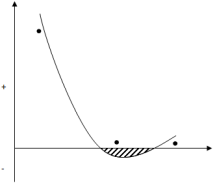It is important that you scrutinize the results of your DOE analysis to determine whether they make sense. If they do not, reduce the range of the input variables and rerun the analysis.
Under some conditions, both the analysis of influences and the analysis of responses methodologies can result in unlikely results, due to limitations in the implementation of the statistical methods. These results can present themselves in the following ways:
- Negative values
-
In order to minimize the number of runs required to produce DOE results for analysis of response experiments, a second order equation is applied to the data. In most cases, this produces logical results. In cases where there is a large differential between the data points, however, for example in the case of a short shot, the second order fitted curve will drop below the x-axis, resulting in negative values.

Solution - if you see negative values, reduce the range of the input data to encompass your area of interest more explicitly and to eliminate the outlying data points, then rerun the analysis. This is done in the Variables tab of the DOE Builder.
- Unlikely or incorrect influence data when running the Taguchi methodology
-
When running an analysis of influences experiment, the number of experiments required using the basic methodology increases on the order 2 x,
where x = number of input variables.
Although the calculated percentage influence of an input variable on a quality criterion is due entirely to that variable using this approach, the analysis time can become prohibitively long. To reduce the analysis time, the Taguchi method is used here to analyze the influence of input variables on quality criteria.
The Taguchi method employs orthogonal combinations to extend the number of variables that can be included, for the same number of runs. Thus, with this approach, selecting 3 variables results in the need for only 4 runs, instead of 23 = 8
Similarly, selecting 7 variables requires only 8 runs instead of 27 = 128.
The disadvantage of this approach is that the calculated influence of the input variable is no longer dependent exclusively on that variable, but now has some contribution from orthogonal associations with the other variables. In most cases this effect is insignificant. However, in the case where the contribution of a given variable is negligible, but it has signigicant cross-influence from other variables, the calculated result will reflect the cross-influence.